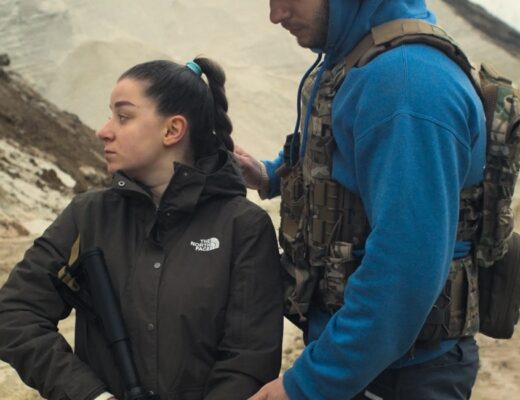French auteur Jacques Rivette’s relationship to novelist Honoré de Balzac lasted throughout his entire life. His fascination first made its way into his directorial work with Out 1, his 13-hour experimental film often regarded as his magnum opus. Featuring an incredible range of characters and plot lines that constantly overlap and collapse in on themselves, the film mainly focuses on the concept of a secret organization hidden within Paris named the Thirteen, a setup that is taken and adapted from multiple Balzac texts. But despite its association and inspired nature, it’s not a direct adaptation, rather merely a homage to the writer who was so adored by the Cahiers du Cinéma directors. In fact, Éric Rohmer himself was the one who told Rivette in the ’50s that “there are two novelists every filmmaker needs to read: Dostoyevsky and Balzac.” Rivette would go on to adapt two more Balzac texts: La Belle Noiseuse, a loosely adapted tale that involves a retired painter who attempts to continue work on his final masterpiece after meeting a beautiful young woman; and The Duchess of Langeais, Rivette’s penultimate film before his death in 2016, a languid and hushed period piece about a doomed romance between French aristocrats in the Napoleon era.
Rivette is wholly unique for a myriad of reasons, but most notably is the strange evolution of his directorial style. Many directors — such as Tony Scott, Jean-Luc Godard, or Clint Eastwood — became progressively more experimental as they bloomed into their late era. Rivette, however, seemed to move in the exact opposite direction, with his radical and experimental era in the ’70s (Noriot, Duelle, Out 1) fading over the course of the ’90s and easing into a style of classicism that remains much more rooted in contemporary Hollywood filmmaking. Of course, Rivette’s films remained anything but contemporary in many other ways: his narrative structures were still impossibly dense, the camerawork remained enticed by incredibly long takes with little cutting, and the concept of conspiracies that play out over the course of many hours never dissipated from his films. The Duchess of Langeais feels like an oddity, then, given just how conventional it appears on a surface level; it feels tight in its narrative structure with little to be found of Rivette’s traditional improv-heavy style.
The film opens with a mysterious island which pulls into a grandiose church, its organs blaring. Armand de Montriveau (Guillaume Depardieu) comes into focus, a Napoleon-era general whose physical and mental pain are visualized through his limp. He is searching for Antoinette de Langeais (Jeanne Balibar), a woman with whom he previously had a tumultuous and sexless, yet emotionally violent, relationship with. Having fled her home country, she has become a nun living in a convent in Majorca, running away from both her shame and desire surrounding her previous romance to Montriveau. Their first meeting in the film is when Montriveau is granted an interview with Antoinette, now named Sister Theresa, and takes place with a physical barrier between them in the form of iron bars. (The scene feels reminiscent of Rivette’s second film, La Religieuse, which is about a woman forced by the cruel hand of both family and state into becoming a nun.) Eventually, Antoinette’s identity is unraveled and the melodramatic tension erupts, but a quick cut takes us abruptly back five years prior, to the first meeting between the two estranged lovers.
Over the course of the next two hours, a deeply melancholic atmosphere permeates every scene. Despite never touching for more than brief moments, there is a palpable sexual tension that arises between them, be it through a placement of a hand on one’s shoulder, a gentle kiss on the forehead, or clutching someone’s entire body close. Both know from the start of their affair cannot last — Antoinette has a husband — yet they seem intent on torturing themselves through continual meetings in secret. Due to the covert nature of their relationship, the couple almost entirely only meet at Antoinette’s large, aristocratic house which forms the main location of the film. When Montriveau first visits her, she feigns an illness so she can greet him in her night dress; Rivette holds a close-up of Antoinette’s face, her mind clearly wondering what move to make next. He swiftly declares his love for her, but her response is flippant, and despite not declaring her love back, she invites him to visit her the next day. These mind games play out in perpetual motion, leaving the film in a constant flux of both melodramatic and psychological conflict which bleeds into almost every frame. Antoinette seems to both reject and embrace Montriveau every time they meet, and in turn, he grows more and more impatient.
This succession of different psychological battles accumulates in an act of violence when Montriveau, along with his fellow group of conspirators, kidnaps Antoinette after she leaves a party and declares he will torture her out of spite. He declares that he no longer lusts for her, that all has been said and he disavows what relationship they had. Despite this act being an attempt to enact violent revenge, it manages to win her back, Antoinette becoming deeply enamored with both the cold and brutal nature of Montriveau’s attempts at justice. Rivette plays this event out like a twisted bourgeoisie declaration of love, a battle of psychosexual passions where Antoinette’s belief in the traditions of class and femininity withers away. It in turn reverses the roles of the two characters — now it is Montriveau’s turn to reject her. We also get a tiny glimpse into the film’s labyrinthine conspiracy: a group of wealthy men — the aforementioned Thirteen — who pull the strings of society. When Antoinette is escorted back to her party, she is brought through a secret door, which connects this world of shadows with the world of the upper crust.
Throughout the whole film, Rivette develops a mise en scène that feels remarkably simple yet graceful. He and cinematographer William Lubtchansky (his ninth collaboration with Rivette) use only a single camera angle to capture the entire film — a direct, straight-on view — which lends the film a grand sense of realism. Rarely does The Duchess of Langeais forcefully draw your attention to a single movement or gesture, instead merely presenting everything on screen and allowing the viewer to decide what is important. When the camera does move, it does not jolt or jump, but rather slowly glides or zooms to gently shift the scene’s focus. This commitment to establishing and maintaining a certain realism can also be found in the film’s beautiful production and costume designs, which are both consistently awe-inspiring throughout the film, helping to elevate it above de facto literary period adaptation. Rivette’s compositions here feel more like masterfully crafted paintings, scenes feeling as if they could have been produced by Gustave Courbet or Jean-François Millet, Rivette’s immaculate and precise blocking imbuing every movement with deep emotional weight.
While The Duchess of Langeais wasn’t Rivette’s final film — he would release his final film, Around a Small Mountain, in 2009 — it distinctly feels like an accumulation of a life’s work. It’s a film so stripped down that it becomes an overwhelmingly raw and powerful study in the obsession and deception that can so often accompany pursuits of love, to the point that it ends up feeling reminiscent of Sirk and even Hitchcock in the process. Those who are fluent in the unique and ethereal nature of Rivette’s earlier work may be disappointed to find something that feels so conventional, but it’s undeniably fascinating to see the director operating in a space of such raw emotionality, and The Duchess of Langeais ultimately becomes a pristine example of how to successfully translate a classic piece of literature into a collection of beautiful images.
Part of Kicking the Canon – The Film Canon.







